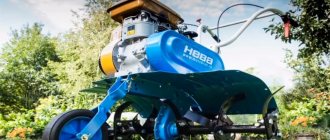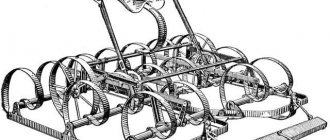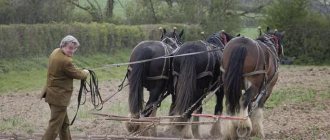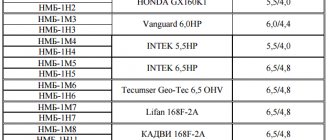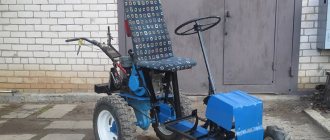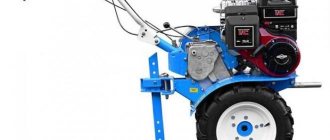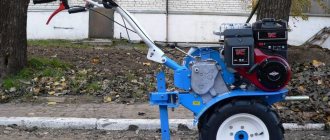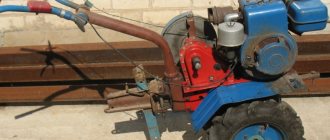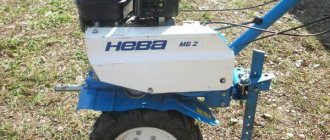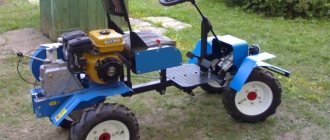The use of horses to plow the land is a thing of the past. Now more constructive and advanced equipment has arrived to help farmers. One of them is a harrow on a walk-behind tractor, which allows you to increase the speed of planting and harvesting crops, and, consequently, increase the yield.
Such devices break up large pieces of soil, retain moisture in the soil, and remove remaining dry grass and its root system. You can make such attachments for a walk-behind tractor with your own hands, which will not only help you save significant financial resources, but also take pride in the work done.
You can make a harrow yourself
Do-it-yourself harrow for walk-behind tractor
To increase work efficiency, and therefore increase yield, attachments such as harrows are used. Previously, horses were used to carry out work on the land, but today the harrow is hung on a walk-behind tractor (if the area is small) or to a tractor (if the area being cultivated is impressive). Therefore, a harrow for a walk-behind tractor is a very important device for any knowledgeable landowner, and if it is made with your own hands, then it is a source of pride. Let's tell you in more detail how harrowing is done using a walk-behind tractor, and how to make this device yourself.
Types of harrows for walk-behind tractors and their design
There are several types of harrows that differ in design and have a number of special features.
Rotary harrow
As for the rotary harrow for walk-behind tractors, its main advantage is good removal of the top layer of soil (soil). Using it to level the soil is also not a problem. The depth of processing with a harrow varies from 4 to 8 centimeters; the depth can be adjusted based on the specifics of the work.
The width of the harrow is also important; it takes into account not only the power of the walk-behind tractor, but also the size of the area being processed. Typically, this value ranges from 800 to 1400 mm. Such dimensions are due to the ability to work comfortably while maneuvering in a small area.
Rotary harrows from honest manufacturers are made of high-quality metal alloy, which allows you to operate the equipment for decades (with proper care and maintenance).
Disc harrow
A disc harrow is used on dry soil; functionally, it does the same work as a rotary harrow, but is fundamentally different in design. Here, the main processing elements are disks shaped like stars. They are installed on one axis at a certain angle, ensuring maximum penetration into the soil.
Tooth harrow
A tooth harrow is a frame on which teeth are located at an equally spaced distance. The standard length of the teeth is 25-50 mm. An example of such a harrow can be seen in the video below.
Types of harrows
A harrow for a walk-behind tractor is a device that is attached to a unit for performing agricultural work. Its purpose:
- Loosen, mix and level the treated soil.
- Remove weeds.
- Thin out seeds planted too closely.
- Destroy the top crust on dry soil.
- Introduce seeds and fertilizers into the soil.
- Improve oxygen saturation of the earth.
Direct contact with the soil surface occurs with the help of tools attached to the frame in the form of teeth, disks, and hoees.
Harrows are divided into different types, depending on their design. They can be toothed, rotary or disc. They are also classified as heavy, medium or light, depending on the design.
In this video you will learn the pros and cons of a harrow: Let's look at all types of devices in more detail, and also find out how you can make a harrow for a walk-behind tractor with your own hands.
Tooth harrow
This type of construction was the earliest known to mankind. A tooth harrow looks like a platform with rows of teeth attached vertically to it. They loosen and level the soil. For walk-behind tractors, a harrow with a large width and a significant number of teeth, which are located in more than four rows and at a short distance from each other, is mainly used. The pulling unit must have good power to ensure deep penetration of the teeth into the soil layer and obtain a high-quality work result.
Important! One of the varieties of tine harrow is the so-called spring harrow, where, instead of pins, springs are used, which make it possible to reduce the size of the structure and contribute to less frequent breakdowns.
A gear-type walk-behind harrow consists of a metal frame with rigidly attached rows of teeth, usually ranging from 2.5 to 5 centimeters in length. They are arranged in a zigzag or at right angles. You can adjust the depth of loosening by installing the teeth in different ways. When the sharp edge is in front, penetration into the soil increases.
There are several types of harrows
The teeth can also be attached to the frame and on hinges. Such devices are used on more uneven areas of land with a significant number of obstacles.
Tooth harrows are used either as a separate attachment or working in conjunction with a plow, seeder or motor cultivator.
Disc harrow
This is a more advanced device in terms of function, providing effective soil cultivation. The disc harrow has many complex design features, so it is recommended to purchase a ready-made product rather than try to make it yourself.
The unit can be either a light type, attached to a small walk-behind tractor weighing up to 100 kilograms, or a heavy one, the maximum weight of the draft device is up to 200 kilograms.
The disc harrow got its name from the working element, which is round discs with a diameter of about half a meter, mounted on one axis. All these cutting devices are fixed in a certain order and at different angles in more than one row, which ensures a significant penetration into the soil.
The discs themselves come in straight and cup shapes. Cup ones have a more complex configuration and are designed to turn over the earth when sowing grains or potatoes early.
The edges of the discs are made uneven to cut the soil better and reduce resistance to the soil layer. At the same time, the layer rises and falls, which contributes to its grinding and breaking into small particles.
Disc harrows are the least susceptible of all types to clogging with soil and plant debris. Consequently, they do not require constant cleaning for a long period, which saves effort and time.
Rotary harrow
The rotary harrow attached to the walk-behind tractor is a mixture of a cultivator and a disc harrow. The main advantage of such a device is that it perfectly removes and levels the top layer of soil, and the depth of treatment is adjustable. It is necessary to correctly determine the ratio of the width of the structure to the power of the walk-behind tractor for the greatest efficiency of work.
Each type of harrow has its own pros and cons
The bending of the teeth of such a device directly depends on the radius of the disk and the amount of sliding of the wheels of the traction unit. The greater the grip on the soil, the more the tooth bends. It enters at an angle of 90 degrees and improves oxygen saturation of the soil.
When using a rotary harrow, large plants are practically not damaged, while weeds that have expanded their root system shallowly are pulled out. The aeration that occurs during this process promotes the intake of minerals and organic fertilizers from the air.
Rotary harrows are either active or passive. The active type is more often used, where the structure is installed instead of the front wheels of a walk-behind tractor. But at the same time, the traction unit must have greater power and the ability to operate at different speeds. When used with other equipment, you can not only loosen the soil, but also level the soil.
The advantages include the ease of use of the design, long service life and efficiency of work. The only drawback is the high purchase price and the significant size of the device.
Do-it-yourself harrow for a walk-behind tractor (drawings)
In order to make a harrow for a walk-behind tractor with your own hands, first of all, you need to study the design of the device, drawings and decide on the dimensions.
What does a harrow consist of?
The design of the harrow is quite simple, the frame is made of a square metal profile, a coupling device that connects the harrow to the walk-behind tractor, and teeth mounted on the frame. It is recommended not to weld the teeth, but to secure them with bolts, then if one of them breaks, it will be easier to replace.
Below are drawings of harrows that give an idea of the required dimensions, attachment points and general layout.
Homemade harrow
An example of a homemade harrow made from two smaller harrows rigidly connected to each other. For longitudinal movement, a hinge from a GAZ 53 car is used. In addition to the hinge and the standard towbar, the harrow is attached with two rods to ensure better performance.
DIY tooth harrow
This device is easiest to make yourself. If you have metal materials, a grinder and a welding machine, then the process will not cause many difficulties.
To produce a harrow for a walk-behind tractor with your own hands, you need to understand the drawings and determine the required dimensions.
The design looks like a lattice with teeth welded to it. If possible, it is recommended to tighten them with bolts to ensure replacement in case of breakdown. A towbar to the walk-behind tractor must be provided in front. To facilitate work, a chain is welded between the two units.
The grille is made of durable materials. They mainly use water pipes and corners with a thickness of more than 4 millimeters so that the teeth do not come off the thin-walled base. A more reliable design involves welding the rods at an angle of 45 degrees to the movement, which reduces loads.
The size of the grid cells should correspond to the size of the teeth. The frame size is designed in such a way as not to interfere with the control of the walk-behind tractor.
The frame should not be made wider than the location of the handles on the walk-behind tractor!
To make teeth, reinforcement corrugated steel with a diameter of about 15 millimeters and a length of up to 200 is usually used. The smaller the tooth, the thinner it is. They are hardened before not being used for strength. When harrowing with a walk-behind tractor is carried out, for efficiency, the elements entering the soil are spaced a maximum of 1 centimeter apart. A slight shift is allowed to ensure greater intensity and quality of work. The build process looks like this:
- First you need to assemble and weld the grate.
- Then attach the teeth using welding or bolts. You need to measure accurately and do it at an angle of 90 degrees.
- At the approximate location of the center of force, it is necessary to weld a chain, one of the links of which is to the grid, the other to the hitch.
- The final stage will be to check the fastening when performing work, and when the harrow moves in any direction, the target is digested.
Regardless of whether the finished product was purchased or whether it was built independently, wet soil and residues of organic crops accumulate on the working elements. Therefore, you should periodically clean the teeth with metal objects or an appropriate scraper.
Harrow for walk-behind tractor Neva
Neva walk-behind tractors are one of the leaders among small agricultural machinery. A harrow for the Neva is no different from harrows for other devices, and you can buy them everywhere.
Here is an example of a rotary harrow for the Neva and other walk-behind tractors, whose shaft diameter is 30 mm.
Rotary harrow RB-1.4 (two sections, 0.7 m each) for the Neva walk-behind tractor.
Designed for pre-sowing and post-harvest tillage.
Working width – 1.4 m;
Diameter – 350 mm;
The bushing diameter is 30 mm;
Tillage depth – up to 100 mm;
Weight of one section – 9 kg;
Disc harrow
Disc harrows are used on dry soils and are practically no different in functionality from rotary active harrows, except that here the working body is discs mounted on independent axes, and they are attached to the walk-behind tractor using a hitch.
Homemade disc harrow
The drawing shows the dimensions for a mini-tractor, so when making attachments for a walk-behind tractor, we adjust all the values to the dimensions of the power unit. One section was borrowed from a large tractor diskator, consisting of 8 lens-shaped disks with a diameter of 450 mm with an interdisk distance of 150 mm. The video clearly shows the operation of equipment made by hand and installed on a walk-behind tractor with an adapter.
Disc harrow drawing
The disk section is movably mounted on a metal frame 1400x650 mm and welded from a 50x50 mm angle. The grip of such homemade equipment is 1200 mm with a depth of up to 100 mm, and the angle of attack is adjustable up to 17˚. As already mentioned, in order to use the harrowing device together with the Neva walk-behind tractor, the length of the frame can be halved and, accordingly, only 4 discs can be used.
Hitches for Neva walk-behind tractors, their types, what for what
To operate any attachment with the Neva walk-behind tractor, it must be connected to the unit. There is a special device for this - a hitch. It comes in several types, let's look at the features of each of them.
Hitch for the APM adapter (for working with a plow and hillers)
This hitch is designed to connect various attachments to the adapter. Such as plows, potato diggers and hillers. The design of the hitch allows you to securely fix the equipment to Neva walk-behind tractors using only three bolts.
Universal hitch
This type of hitch allows you to adjust the angle of the attachment using a bolt mechanism. This function allows you to tilt the Neva walk-behind tractor, and the plow will go perpendicular to the ground.
Since this hitch is mainly intended for the use of plows and hillers, it is possible to install a double or triple hitch so that several working elements can be connected to it at once.
Universal hitch N
This is a modification of the universal hitch for the Neva walk-behind tractor. Its main difference is that you can not only adjust the height of the dive, but also change the angle of inclination in all planes. The maximum tilt angle in the horizontal plane is ± 20 °, and in the vertical plane ± 27 °.
MK hitch for working with hiller OH-2 and plow KROT
This coupling is special in itself, since it was produced exclusively for coupling with their ON-2 and Krot equipment. The factory thought out a separate type of clutch, which is not supplied in the kit, but must be purchased separately.
Is it possible to make a hitch for a walk-behind tractor with your own hands?
When making a hitch with your own hands, it would be most correct to choose a universal option, since 90% of attachments work with this type of clutch.
Types of attachments
Attachments vary in scope of application. It can be classified according to its scope of application, for:
- soil cultivation - usually these are cutters to increase the plowing width, lugs or wheels with lugs, a plow and a hiller;
Potato planter for walk-behind tractor
- special planters are used for planting, for example, potato planters, which are a bunker on wheels;
- harvesting, devices are used for digging up root crops, for example, potato diggers;
- for mowing grass, mowers have been developed, which differ, in turn, into rotary mowers with rotating discs for processing coarse vegetation and blade mowers;
- brushes and snow blowers are used for cleaning;
- For transportation of goods, trolleys are used, the fastening of which requires couplings.
- You can also mention special weights on the wheels and on the body, which increase the traction force of the walk-behind tractor by increasing the weight.
Several types of attachments have been developed for the Neva walk-behind tractor: these are plows, hillers, potato diggers, couplings for them, lugs, carts, snow blowers, brushes, shovels and weights.
For more information about the attachments for the Neva walk-behind tractor, watch the video:
Homemade cutter attachment
The Neva walk-behind tractor comes with 8 cutters with a diameter of 36 cm for loosening soil 20 cm deep with a strip width of 120 cm. However, these cutters have one drawback - they are functional only when working with already cultivated soil.
If the soil is untouched or has not been treated for at least a year, their functionality drops sharply and they quickly break. Therefore, when purchasing a walk-behind tractor, you should immediately consider the possibility of purchasing additional attachments. The most popular mechanisms for a novice farmer are the plow and hiller.
Plow for the Neva
The plow for the Neva walk-behind tractor is perhaps the most important equipment for a farmer. It is used for plowing soil and cutting furrows. Its configuration allows you to cut layers and turn over a layer of soil. The quality of a plow depends on the steel from which it is made, its geometry, the shape of the share and even the design of the heel.
Plow
To mount the plow, a hitch is required that can adjust its position in 3 planes. Models of plows with and without couplings are available for the Neva. The mounted plow P 1 20/3 works at a depth of up to 215 mm, the strip width is 220 mm. This model weighs 7.8 kg and has dimensions of 535 mm to 310 mm to 400 mm.
You can also find the N plow and the PNS-SN model on sale.
Reversible plows can also be used. A special feature of this type of equipment is 2 housings, which allow you to process the soil without skipping. A reversible plow is usually installed on heavy walk-behind tractors, so if the Neva does not have enough weight to install it, you can use weights.
How to make lugs and cultivators with your own hands
So that the walk-behind tractor can go deeper into the ground and not slip, special metal wheels with lugs are mounted on it. They are installed for hilling the soil, weeding, plowing, and digging up root crops.
The lug configuration promotes efficient operation and prevents the unit from tipping over at high power. The walk-behind tractor with lugs moves through loose soil easily and efficiently. KMS wheels weigh 12 kg each, are produced with a diameter of 460 mm and a width of 215 mm.
Lugs
Metal wheels KUM with a diameter of 700 mm and a thickness of 100 mm are intended for hilling. Each KUM wheel weighs 15 kg. K-T wheels with a diameter of 680 mm and a cultivation width of 90 mm are also used for hilling. Each K-T wheel weighs 10 kg. For the Neva, lugs F 340x110 may be suitable, where the width is 110 mm and the height is 340 mm.
Hiller for walk-behind tractor
The hiller is a metal frame on support wheels, with rotary harrows for a walk-behind tractor attached to it. This is an effective tool that helps form furrows for planting. Hillers are used to add soil to the roots, loosen the soil, and control weeds.
Hillers can sometimes be used both as a cutter and as a plow. Several types of hillers have been developed for the Neva: single-row OH2/2, double-row STV, double-row OND without coupling and with coupling.
OND hillers cultivate soil up to 220 mm deep, other models up to 200 mm deep. Double-row hillers have adjustable row spacing from 400 mm to 700 mm. When purchasing hillers, you should pay attention that double-row hillers weigh from 12 kg to 18 kg and are quite impressive in size.
Hiller
The single-row hiller is more compact, weighs only 4 and a half kilograms and has dimensions of 540 mm by 170 mm by 445 mm.
Potato digger
A potato digger is one of the most popular types of attachments among the population. It can greatly improve harvesting efficiency. Sometimes gardeners try to dig up root crops with a plow, but some of them spoil.
The Ivanovets 25-ton truck crane is a product of the latest developments in the field of creating special machines for moving and installing various structures, as well as one of the examples that have become objects of global modernization. Ivanovets truck crane for 25 tons - power and reliability.
Digging beds requires a huge amount of effort and also takes a long time. The Texas walk-behind tractor is reliability and European quality.
Snowmobiles are an indispensable form of personal transport in the northern regions. It's all about the beautiful Japanese snowmobile Yamaha.
The potato digger carefully and accurately turns the soil and lifts the potatoes to the surface without damage. In addition to potatoes, the equipment will help you harvest beets, onions, and garlic. The depth and speed of excavation can be adjusted before starting work.
The KNM mounted potato digger processes soil up to 22 cm deep, with a strip width of 25 cm. Weighing only 5 kg, the potato digger has dimensions of 560 mm by 370 mm by 540 mm.
Potato digger
Also suitable for the Neva are universal potato diggers: KV3 for light soils, and KV2 for heavy soils. The KV-2 is smaller and lighter than the KNM and covers a larger area of soil at a time. It has a soil grip width of 30 cm, weighs 3 kg and has dimensions of 540 mm by 300 mm by 445 mm.
Potato planter
A potato planter will help plant the tubers equidistantly at the desired depth. The components of this unit are a bunker and spoon-disc devices for planting. In each bunker, augers deliver tubers for planting to the planting apparatus, and there are also shakers. The tuber planting step is adjustable.
Hitch
To attach any attachment to a walk-behind tractor, you will need a hitch. The mechanism can be equipped with a hitch or it can be purchased separately. Each walk-behind tractor has its own specific coupling mechanism, just like the Neva walk-behind tractor.
There are hitches designed specifically for hanging a specific type of equipment: for example, hitches for the N plow and STV hiller and a hitch for the PNS-SN plow and OND hiller.
Hitch
For other mechanisms, the Base hitch and CB1/1 hitch are suitable. The first is quite compact and weighs only 2 and a half kilograms. Its dimensions are 220 mm by 130 mm by 200 mm. It only applies to attachments. The second hitch is more massive, weighs 3.6 kg and has dimensions of 435 mm by 130 mm by 175 mm.
In addition to a plow, hiller, and potato digger, it can work with a frame with two locks.
Cart
Sooner or later, every owner of a walk-behind tractor thinks about buying a cart or trailer for transporting all kinds of cargo. A trolley is a metal structure on tipper or conventional wheels. The following types of trolleys have been developed for the Neva:
- single-axle dump truck;
- two-axle chassis;
- TPM;
- TPM-M.
A single-axle dump truck can transport 250 kg, but itself weighs 56 kg. The two-axle trolley can transport 500 kg, but itself weighs only 40 kg. The body dimensions of these two models are the same: 1100 mm by 900 mm and the side height is 350 mm.
Single axle trolley
The TBM trolley can transport up to 250 kg and has a body size of 1330 mm by 1110 mm by 300 mm. The TPM-M trolley is capable of transporting only up to 150 kg and has body dimensions of 140 mm by 825 mm by 250 mm. The first weighs 110 kg, the second model – 85 kg.
Mower
A mower may be needed not only to make hay for livestock, but also to create an evenly trimmed lawn on your garden plot. The device is equipped with several knives. You can manually or electrically adjust the cutting height of the grass.
The KR 05 mower has been specially developed for the Neva walk-behind tractor. It is capable of mowing a strip of grass 56 cm wide in one pass, moving across the area at a speed of 0.2-0.4 m/sec and providing a cutting height of up to 4 cm. The mower weighs 30 kg.
Mower
You can also consider purchasing a KN1.1 blade mower, which can mow a strip of grass 1,100 mm wide in one pass, leaving a cutting height of up to 4 cm. This mower moves at a speed of 3.6 km/h and weighs 45 kg. You can consider rotary mowers.
The Zarya rotary mower processes a strip of grass up to 80 cm wide in one pass and can mow 0.15 hectares per hour. Rotary mowers are more efficient, but blade mowers are much more maneuverable, allowing you to carefully mow areas between trees and bushes.
Other additional equipment
The walk-behind tractor can be used for cleaning both in summer and winter. To do this, you just need to purchase special cleaning equipment. The rotary brush for the Neva ShchRM walk-behind tractor allows you to sweep any area with a working width of up to 880 mm at a speed of 1 m per second.
The brush can handle dust, dead leaves, debris and even freshly fallen snow. If you need to move a pile of sand or a snowdrift, you can attach a shovel blade, which can cover an area up to 1,000 mm wide.
When there is a lot of snow, you should use an SMB rotary snow blower, which will grind even icy areas. Snow is thrown up to 5 m.
19-kilogram weights will help make the walk-behind tractor heavier to provide greater traction. It would be a good idea to purchase an adapter with a seat for the Neva, which will make it much easier to control. You can also try making an adapter for a walk-behind tractor with your own hands.
Harrows
The harrow is designed to mix the top layer of soil (for uniform fertilization, moistening or aerating the soil) and bringing it into a homogeneous state (removes crust on the ground, breaks up lumps, removes weeds). One official harrow model is presented on the official website of the manufacturer of walk-behind tractors Neva.
Harrow BD 850M (husker)
The harrow breaks large pieces (blocks) of soil into smaller ones, thanks to which the soil additionally absorbs moisture and oxygen. These two factors are mandatory for growing crops.
BD 850 is a disc harrow and is recommended for use in small or medium-sized fields. In this case, the width of the work can be adjusted from 70 to 96 cm.
The harrow is equipped with 8 high-quality steel discs. They are replaceable and, if desired, old ones can be easily exchanged for new ones. The discs are sharpened at the factory using a special technology, thanks to which they do not become dull over a long period of operation.
Discs are installed on the axle. These axles are mounted on heavy-duty Teflon bearings.
The furrow angle can be changed depending on the conditions:
- An inclination of 10° is used for aggressive furrowing;
- An inclination of 15° is used for standard furrowing;
- An inclination of 20° is used for soft furrowing.
If hard rock is being processed and the discs slip, then a weighting agent can be used to sink them into the ground. For this purpose there is a special well-thought-out platform on top.
To achieve maximum furrowing results, two furrows can be used in series. In this case, the first unit dumps the earth inside, and the second outside.
It is also recommended to replace regular wheels with lug wheels.
Is it possible to make a harrow with your own hands?
If desired, you can assemble the harrow yourself; there is nothing complicated in this design.
The easiest way to make a toothed harrow. It is slightly less efficient than disk, but the device is much simpler.
All you need is a square tube, teeth and bolts.
It is necessary to cut the pipes and connect them to each other at an angle of approximately 30 °. And at the place where they connect, insert the teeth and secure them with bolts.
To connect to the walk-behind tractor, you can use a regular chain or make a coupling device using a regular metal pipe.
But this structure will often jump out of the ground; it needs to be additionally weighted with something. The ideal solution to the problem would be cinder blocks or any heavy metal structures. But you should not overdo it, since the connecting elements must support the weight of the entire structure.
Video review
The video demonstrates the manufacturing process of such a harrow: And here is a video of the harrow in action and the result of the work done:
What the owners say
Here are a few opinions from people who have already worked with harrows on Neva walk-behind tractors.
Alexey writes:
“I decided to make the harrow myself, since its design was intuitive to me. Therefore, after thinking a little and collecting information on the forums, I was able to do it without any problems. All that was needed were pins and pipes to attach them. Simplicity is the key to success)"
Traditional harrow
The classic, or as it is also called, horse harrow, is used to create a smooth and loose surface. Also, this type of attachment allows you to effectively cover moisture in the soil and thereby prevent it from drying out. The harrow crushes large lumps of earth to the required fraction, destroys weeds and removes remnants of vegetation from the soil. The equipment is quite lightweight and is therefore used for surface tillage, crushing clods of earth and shallow loosening before sowing.
The tooth harrow for factory-produced walk-behind tractors is made of special structural steel that can withstand significant loads. Also, this equipment does a good job of leveling the soil after milling.
This type of harrowing equipment is a straight or zigzag frame that you can make yourself from a steel strip, a square pipe or angle, a stand for coupling with a walk-behind tractor and teeth. The teeth can be secured to the frame by welding, or by cutting threads on them and securing them with nuts. The working bodies on the frame are located at an even distance from each other, and their length can be 25-45 mm. Regarding the width of the equipment, for example, for the Neva walk-behind tractor, 500-600 mm is quite enough. The video below shows a tooth harrow in action.
Diagram of a tooth harrow for a walk-behind tractor
In order to make such equipment for a walk-behind tractor, we will need the following:
- Weld iron strips to a square metal pipe, onto which, in fact, teeth with threads cut on one side will be attached using nuts;
- the drawbar of our attachment ends in a welded bushing, through which a connection with the walk-behind tractor used will be made using a metal pin;
- We make a stand with an adjusting screw to adjust the lifting height of the harrowing device to ensure uniform penetration of the working parts into the soil.
Even purchased factory equipment, even a homemade harrow, for the Neva walk-behind tractor, has the peculiarity of accumulation of wet soil with vegetation residues on the working parts, as a result of which tillage may become ineffective. In order to easily and smoothly clean the teeth with a scraper or any metal object, we use the lifting lever of the unit.
The video shows the simplest tooth harrow for a walk-behind tractor with dimensions indicated.
Weights
Weights are used to add more weight to the structure. This is necessary in cases where the equipment “jumps” over the soil and operates intermittently.
Weights can be used both for the walk-behind tractor itself and for attachments to it.
Weights for the Neva walk-behind tractor
The official manufacturer offers to buy weights on its website. There are two types.
The first ones are made in the form of disks; they are designed to weigh down the wheels or axle of the walk-behind tractor. The discs improve the soil-clinging properties; the weight of one disc is 10 kg.
The latter are produced in the form of a cylinder, which is attached only to the pin of the walk-behind tractor. Thus, burdening its frame, the weight of one such cylinder is 17 kg.
But you shouldn’t buy a weighting material right away. After all, this is not an attachment. Its task is to make the structure heavier. Maybe you just have a cinder block, a metal dumbbell, or something else weighing about 10 kg at home? So just hang it on the walk-behind tractor, and the result will be the same.
But these manipulations should be carried out correctly, since otherwise there is a high risk of the weighting material falling off the mount and causing injury to a person.
Video reviews
Here is an example of how you can make and install a weighting material for a Neva walk-behind tractor yourself:
And this video talks about how to correctly install the disc weight directly on the wheels themselves for the Neva walk-behind tractor:
Owner reviews
Here are some comments from the forums about weights.
Igor writes:
“A problem has long been noticed that when working with hard soil, the walk-behind tractor does not catch on the ground, but slips, even with lugs. After surfing the forums, I found a solution: just add more weight. I didn’t buy a new one, but built it myself from scrap metal. The effect is amazing. Now I work without failures"
Vladimir writes:
“During the operation of the cutters, a problem was noticed; they did not dig into the ground, but slipped through. So I decided to make them heavier. To do this, I hooked weights from a barbell onto the wheels. Fortunately, they remain from younger times. The effect was noticed immediately."
Possible attachments for the Neva walk-behind tractor
By purchasing a Neva walk-behind tractor and its attachments, owners of land plots have powerful and multifunctional agricultural equipment at their disposal. Neva walk-behind tractors have been produced in St. Petersburg for more than 30 years. During this time, the products were repeatedly modified and supplemented with various options. Today, the Neva MB walk-behind tractor is the most popular hand-held equipment, which is distinguished by high quality workmanship, reliability and long service life.
Motoblock Neva: attachments - potato planter
We mentioned a canopy for the walk-behind tractor, which helps us dig up the potatoes after they are ripe. But you can not only collect potatoes using a walk-behind tractor, but also plant them before that. There is a potato planter for this.
For the Neva walk-behind tractor, take the KSM-1 potato planter. A good device for planting tubers in a summer cottage. In addition to the Neva walk-behind tractor, it also fits the Cascade, Mustang and ZIRKA walk-behind tractors, but unlike the last two, the potato planter does not need an adapter to connect to the Neva.
Coma KSM-1 will fit KSN-1 to the Neva walk-behind tractor. This single-row device is good because it is suitable for all types of walk-behind tractors: light, medium and heavy.
Weights for walk-behind tractors
The main problem for the Neva MB walk-behind tractor is slipping on wet ground and on inclines. With a low weight (98 kg), the unit does not exert sufficient pressure on the ground to create reliable traction. Lightweight attachments do not help eliminate this disadvantage.
To increase the weight, the following devices are attached to the motor-cultivator and walk-behind tractor:
- Wheel weights. Factory products are monolithic iron circles or hollow containers filled with sand. Homemade products are not inferior to their factory counterparts in quality. They are made from barbell discs, cast from concrete, or assembled from parts of a metal barrel. The weights are attached to the axle hub. Their weight can be 20-50 kg per wheel.
- Body weights. They are made in the form of a frame from steel corners, rigidly fixed to the frame of the unit. Drawings and calculations are made in advance so that the frame fits exactly into place. Pieces of iron or containers with water/sand are attached to the frame.
- Steel wheels with lugs. These products have a steel strip instead of a tire, to which plates of the same material are welded. The diameter of the lugs varies between 30-70 cm, width - 10-20 cm, weight - 15-50 kg.
By making the walk-behind tractor heavier, you can count on its smooth progress across the site even when cultivating virgin soil. After this, you need to purchase or make your own attachments for the Neva walk-behind tractor. The scope of agricultural activity is quite wide; to cover it all, you will need a wide variety of attachments for the Neva MB 2 walk-behind tractor.
Standard reversible plow for the Neva walk-behind tractor
If you use your plow to plow the land before planting crops, instead of a standard mounted plow, you can attach a reversible plow to the Neva walk-behind tractor. The advantage of this variety is that the plow has two bodies, so there are no gaps in tillage.
The reversible plow is installed on 100-kilogram units; larger weights are possible. Of course, if the walk-behind tractor is a little smaller, you can always hang a weighting device. It is good to buy such a canopy for the Neva walk-behind tractor. When plowing, Zykov's plow covers the soil to a width of 19-23 cm. In addition to the Neva, the reversible plow can easily be connected to the Zubr, Salyut and ZIRKA walk-behind tractors.
For plowing and cultivating land
There is a generally accepted scheme for cultivating land for planting garden crops or grass. Any work begins with plowing. For this you need a plow and a harrow for the Neva walk-behind tractor. Virgin soil is raised using single-row or double-row plows. The choice depends on the density of the soil and the depth of the root system of the plants growing on it. The mounted plow P1 20/3 allows you to make furrows up to 23 cm deep. The plowing area can be up to 0.1-0.12 ha/h. This is comparable to the efficiency of a mini tractor.
After the soil is plowed, it must be cleared of weeds, branches and debris. You will need a milling cutter and rake for the Neva walk-behind tractor. The cultivator breaks up large clods of earth, and the rake removes foreign objects from it. Most farmers prefer to make their own rakes. Homemade attachments are not inferior to factory-made analogues, and in terms of strength and reliability they can significantly exceed them. The rake is made from sheet metal and reinforcement. The finished product is attached to the frame of the unit with chains or a steel cable.
Manufacturing of disc harrows as a business
A properly made harrow will cope well not only with the densest layers of soil, but will also perfectly counteract weeds and dead wood. It will also be able to grind sunflowers and corn, which is not possible for other types of agricultural equipment.
By making your own disc harrow, you will save a lot of money. In addition to the many other advantages that this unit has, we can also highlight the fact that the disc harrow has high productivity and does not clog. This means that you can quickly process the entire field with it without any problems!
Having mastered your own production of disc harrows for MTZ-80, T-150 tractors and other types of tractors, you can start a profitable business. Experts estimate its profitability at 50 percent (it all depends on the cost of the materials you will use in production).
By setting up the production of disc harrows, you can achieve a monthly profit of $1000. Despite the fact that you are selling expensive equipment, its demand is ensured by the good solvency of the target consumer (farmer). There is nothing to wait! Time to open your own business!
People involved in agricultural activities have probably come across the concept of “diskator”. However, most farmers do not attach due importance to this type of equipment, preferring to use more conventional harrows for cultivating the land.
Let's figure out what the advantage of disk drives is over similar types of trailed equipment.
For mowing fields and lawns
If there are cows on the farm, then before plowing the field it is advisable to mow the grass from it, which can be dried. Mowing is best done using a mounted rotary mower equipped with blades. This is a fairly large and effective device that makes a strip up to 80 cm wide. In an hour of operation, the Zarya rotary mower can mow up to 0.15 hectares of dense vegetation.
For quick and high-quality hay harvesting, it is advisable to purchase a pick-up for a walk-behind tractor. As a rule, such equipment is used to equip wheeled tractors. However, the design of the Neva walk-behind tractor allows the use of small balers. To reduce manual work to a minimum, you should buy a baler that performs the entire range of operations with mown hay - compacts it, rolls it and ties it with a nylon cord. All that remains for the walk-behind tractor operator to do is attach a trailer to the unit and collect the packed hay into it.
When processing virgin soil, a lot of waste is generated in the form of roots, branches and thick stems. There is no need to rush to burn them or remove them to the edge of the field. Plant scraps can be used to make excellent nutritious compost. To do this, purchase a branch chopper for a walk-behind tractor. With its help, useless garbage is turned into valuable fertilizer. A chopper for a walk-behind tractor can be delivered to the field on a trailer attached to the unit itself or in the trunk of a car. The chips obtained as a result of crushing can be left in place or partially removed for further use in floriculture.
Planting and harvesting potatoes
This vegetable is grown in any farm and in the country garden. When planting a large number of tubers, it is advisable to use the KSM-1 potato planter. This simple and reliable device immerses tubers to a depth of up to 20 cm. The risk of damage to planting material is completely eliminated. To couple with the Neva unit, an adapter is not required, which is a big plus.
The undoubted advantage of the Neva brand walk-behind tractor is that you can attach a KNM potato digger to it. Weighing only 5 kg, this device collects tubers from a depth of up to 22 cm, with a working width of 25 cm. This ensures complete harvesting with minimal chance of damage.
The KV-2 potato digger is more effective. It sinks into the ground up to 25 cm, providing a width coverage of 30 cm. The dimensions of the potato digger are 550x300x440 mm and weighs 3.2 kg.
Harrowing with a walk-behind tractor
When harrowing with a toothed harrow, the plowman follows the walk-behind tractor at medium engine speeds - about 2 km/h.
Heavy soils require placing a load on the harrow; the weight of the load is selected experimentally. The plowman follows the walk-behind tractor and regulates the movement of the harrow using the handles of the walk-behind tractor. If necessary, the part of the harrow that does not go deep or is knocked out when moving forward is pressed down with the foot. Harrowing with a disc harrow is similar to cultivating soil. Work is carried out at a speed of 1.5-2 km/h. The plowman follows the walk-behind tractor, adjusting the movement of the harrow using the handles - the axis of rotation of the harrow must be strictly perpendicular to the required direction of movement of the walk-behind tractor.
Agricultural work cannot be done without the use of a functional harrow. It is impossible to carry out sowing without destroying the top crust of the earth and without digging up the soil to a loose consistency, thereby destroying all the weeds. That is why the presence of a disc harrow in every farm is an urgent need.
You can organize your own production of disc harrows at home if you have a garage, a welding machine and additional tools. Farmers are clients with good solvency. If you make your offer with a lower price but the same quality, then you can easily sell an expensive disc harrow unit. After all, this type of agricultural equipment brings large incomes to farmers.
For soil cultivation
Vegetable gardens, beds and fields must be processed periodically. Otherwise, the earth will become covered with a dense crust, and weeds will clog the garden crops. In order to provide the roots of the plant with oxygen and prevent them from rotting from dampness, the beds are hilled. The purpose of this activity is to create a hollow between the rows of plants and a mound above their roots. Single or double nozzles are used. The double-row hiller weighs up to 15 kg, sinks into the ground by 8-12 cm and covers a width of 35-50 cm. The single-row disc hiller for the Neva walk-behind tractor allows you to process up to 0.2 ha/h at maximum forward speed. The turn is carried out quickly due to the activation of the axle shaft disconnection mechanism. The turning radius is only 110 cm, which greatly simplifies and speeds up work.
An indispensable device for weed control is a mounted weeder for a walk-behind tractor. This product removes plants from the soil along with the root system, which eliminates the prerequisites for subsequent overgrowing of the beds. The design of the weeder is well thought out. While removing weeds, this device does not affect the stems, tubers and roots of garden crops.
Trailed equipment
The capabilities of the Neva walk-behind tractor are not limited to plowing and cultivating soil. Living in a private house is inextricably linked with the need to transport various goods. The design of the unit suggests the possibility of attaching a wheeled trolley or sleigh on runners to it. The trolley is equipped with one or two seats. The location of the operator's seat provides convenient access to the controls of the walk-behind tractor. If necessary, the trolley is equipped with a headlight and parking signals.
The overall dimensions of the trailer are 2200x1130x960 mm with a body size of 1150x835x250 mm. Depending on the model of trailers, their carrying capacity is 150-250 kg, not counting the operator’s weight. The weight of the trailers themselves varies between 85-130 kg. The trolleys are designed to move on level terrain at a maximum speed of 12 km/h with no sharp turns. Driving on curved sections is permitted at a speed of no more than 4 km/h.
Trailed sleds are designed for transporting goods and transporting people through snow and swampy areas. The average size of a sled is 200-250 cm in length, 120-140 cm in width and 20-40 cm in height. The sled is made of plastic and weighs 10-15 kg.
Mounted snow removal equipment
Almost all models of walk-behind tractor are adapted for attaching devices for clearing snow from the local area.
The Neva can be equipped with the following snow removal equipment:
- Rotary canopy SMB-1. The product is rigidly fixed to the hitch and connected to the power take-off shaft. The snow blower captures a strip 60 cm wide with a cover height of up to 25 cm. The captured snow is thrown to the side at a distance of 5 m. At average speed, a walk-behind tractor with a snow blower can process up to 150 meters of paths and paths per hour. The rotary mechanism successfully copes with crust and compacted snow.
Blade knife. It is used for removing snowdrifts and clearing garden paths of fresh snow up to 20 cm deep. Depending on the model of the canopy, the blade width can be 60-100 cm. The manufacturer produces stationary blades and with the ability to adjust the horizontal angle.
- Rotating brush. Designed for cleaning freshly fallen snow on a flat surface (platforms, paths). The working width is up to 90 cm. Some models provide the ability to rotate the rotor mechanism. The weight of the attachment is 50 kg.
After the snow melts, you can attach a pump to the walk-behind tractor. It is used to pump water out of drainage wells, flooded basements and lowlands. The Neva will also help out in the event of an accident on a power line. A portable generator of up to 5 kW is connected to the power take-off shaft, which is quite enough for the full functioning of the house, outbuildings and external lighting.
Tooth harrow – advantages and applications
The design of a tooth harrow includes trough-shaped and rectangular bars, at the intersection of which there are teeth. The latter are installed in such a way that during operation each of them leads its own furrow. Depending on the type of harrow used, the distance between furrows can range from 220 to 490 mm.
In order to prevent clogging of the harrow with weeds and soil, adjacent teeth are located at a distance of 15 cm. The depth of tillage when working with the harrow depends on the force of the teeth on the ground, as well as on the length of the leads connecting them.
Depending on its design, the teeth on a harrow can be straight, curved with a special spring strut, or clawed.
All teeth in the harrow design are mounted on a hinged or rigid frame. Harrows with articulated mounts are more preferable in areas where there are a lot of uneven surfaces.
Structures with a rigid frame should be used on more or less flat surfaces.
Tooth harrows for walk-behind tractors are used to solve the following problems:
- cutting and crumbling turf;
- chopping and pulling molehills across pastures and meadows;
- effective combing of grass.
The design of tooth harrows allows them to be used not only as independent attachments, but also to work together with cultivators, seeders and plows.
Main characteristics
The Neva walk-behind tractor is used for secondary tillage. The design includes a shank that pierces the soil, grips it and turns it over. When viewed from a design point of view, the technique refers to machines that use the rotational movement of disks or teeth. The rotary cultivator of this line is a perfect example.
Walk-behind tractors are used before sowing or after the crop has begun to grow to remove weeds . Thus, operator-controlled disturbance of the soil layer near the plants kills unnecessary plants and uproots them. Neva gear-type products are often similar in shape to chisel plows, but they have different purposes. The technique works close to the surface, while the plow is deep below the surface.
All the company's units can be described as compact equipment with a low center of gravity.
Thanks to this design, it is more convenient to work on a walk-behind tractor; there is no risk that the equipment may lose balance and roll over.
All models have an engine from Subaru , and along with it an electronic switching system is installed. All units have a front wheel for moving, and the compact dimensions allow the walk-behind tractor to be transported in the trunk of a car.
Power may vary depending on model. This figure is in the range from 4.5 to 7.5 horsepower. The working width is from 15 to 95 cm, the immersion depth of the cutters is up to 32 cm, most often the fuel tank volume is 3.6 liters, but on some models it reaches 4.5 liters.
The gearbox installed in the Neva walk-behind tractors is three-speed and V-belt. This equipment runs on AI-95 or 92 gasoline ; other fuel cannot be used.
The type of oil depends on the conditions in which the walk-behind tractor is operated. This could be SAE30 or SAE10W3.
Some walk-behind tractors have an engine with a cast-iron sleeve; simpler vehicles have one speed forward and the same speed backward. There are multi-speed units that can be switched between three speeds. Most walk-behind tractors can replace a small tractor ; they can not only cultivate the soil, but also transport various loads. Such equipment is capable of accelerating from 1.8 to 12 kilometers per hour; accordingly, the models have different motors.
On average, a semi-professional engine is designed to operate without breakdown for up to 5 thousand hours. The housing, made of aluminum, protects against moisture and dust.
The maximum weight of the walk-behind tractor reaches 115 kilograms, while this model is capable of transporting cargo weighing up to 400 kilograms.
Special attention to the gearbox. In the Neva design it is gear-chain, so we can talk about its reliability and strength. Thanks to it, the equipment can demonstrate stable operation on any type of soil.
